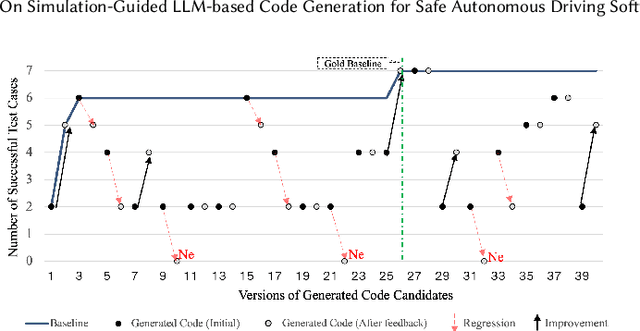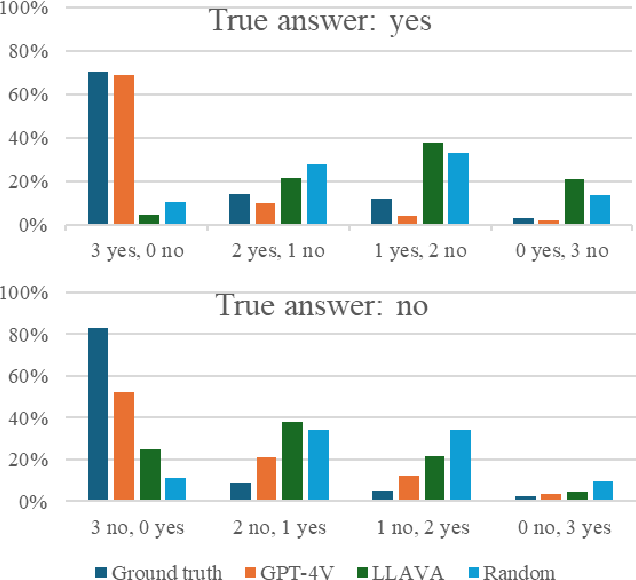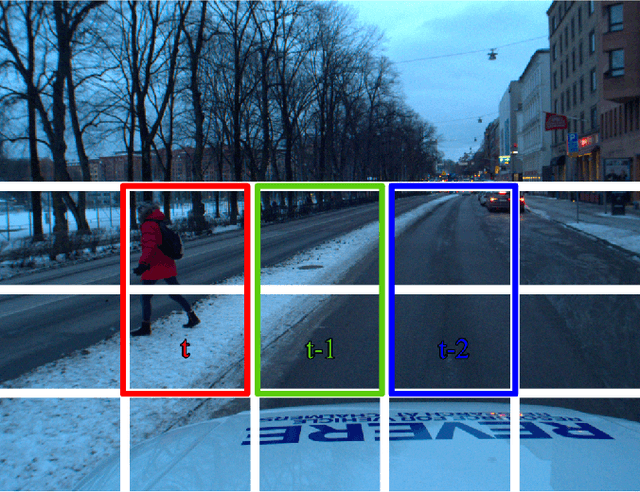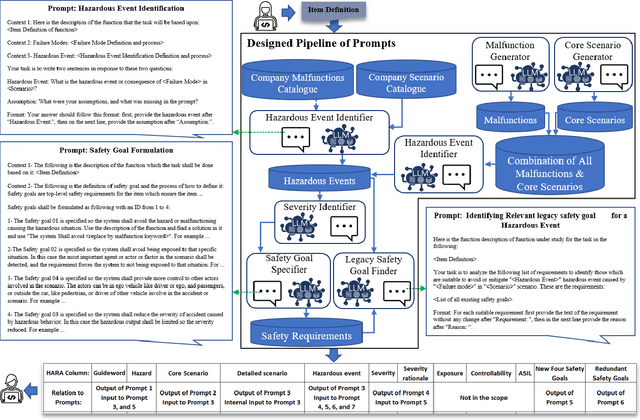Beatriz Cabrero-Daniel
BetterCheck: Towards Safeguarding VLMs for Automotive Perception Systems
Jul 23, 2025Abstract:Large language models (LLMs) are growingly extended to process multimodal data such as text and video simultaneously. Their remarkable performance in understanding what is shown in images is surpassing specialized neural networks (NNs) such as Yolo that is supporting only a well-formed but very limited vocabulary, ie., objects that they are able to detect. When being non-restricted, LLMs and in particular state-of-the-art vision language models (VLMs) show impressive performance to describe even complex traffic situations. This is making them potentially suitable components for automotive perception systems to support the understanding of complex traffic situations or edge case situation. However, LLMs and VLMs are prone to hallucination, which mean to either potentially not seeing traffic agents such as vulnerable road users who are present in a situation, or to seeing traffic agents who are not there in reality. While the latter is unwanted making an ADAS or autonomous driving systems (ADS) to unnecessarily slow down, the former could lead to disastrous decisions from an ADS. In our work, we are systematically assessing the performance of 3 state-of-the-art VLMs on a diverse subset of traffic situations sampled from the Waymo Open Dataset to support safety guardrails for capturing such hallucinations in VLM-supported perception systems. We observe that both, proprietary and open VLMs exhibit remarkable image understanding capabilities even paying thorough attention to fine details sometimes difficult to spot for us humans. However, they are also still prone to making up elements in their descriptions to date requiring hallucination detection strategies such as BetterCheck that we propose in our work.
Large Language Models in Code Co-generation for Safe Autonomous Vehicles
May 26, 2025Abstract:Software engineers in various industrial domains are already using Large Language Models (LLMs) to accelerate the process of implementing parts of software systems. When considering its potential use for ADAS or AD systems in the automotive context, there is a need to systematically assess this new setup: LLMs entail a well-documented set of risks for safety-related systems' development due to their stochastic nature. To reduce the effort for code reviewers to evaluate LLM-generated code, we propose an evaluation pipeline to conduct sanity-checks on the generated code. We compare the performance of six state-of-the-art LLMs (CodeLlama, CodeGemma, DeepSeek-r1, DeepSeek-Coders, Mistral, and GPT-4) on four safety-related programming tasks. Additionally, we qualitatively analyse the most frequent faults generated by these LLMs, creating a failure-mode catalogue to support human reviewers. Finally, the limitations and capabilities of LLMs in code generation, and the use of the proposed pipeline in the existing process, are discussed.
On Simulation-Guided LLM-based Code Generation for Safe Autonomous Driving Software
Apr 02, 2025



Abstract:Automated Driving System (ADS) is a safety-critical software system responsible for the interpretation of the vehicle's environment and making decisions accordingly. The unbounded complexity of the driving context, including unforeseeable events, necessitate continuous improvement, often achieved through iterative DevOps processes. However, DevOps processes are themselves complex, making these improvements both time- and resource-intensive. Automation in code generation for ADS using Large Language Models (LLM) is one potential approach to address this challenge. Nevertheless, the development of ADS requires rigorous processes to verify, validate, assess, and qualify the code before it can be deployed in the vehicle and used. In this study, we developed and evaluated a prototype for automatic code generation and assessment using a designed pipeline of a LLM-based agent, simulation model, and rule-based feedback generator in an industrial setup. The LLM-generated code is evaluated automatically in a simulation model against multiple critical traffic scenarios, and an assessment report is provided as feedback to the LLM for modification or bug fixing. We report about the experimental results of the prototype employing Codellama:34b, DeepSeek (r1:32b and Coder:33b), CodeGemma:7b, Mistral:7b, and GPT4 for Adaptive Cruise Control (ACC) and Unsupervised Collision Avoidance by Evasive Manoeuvre (CAEM). We finally assessed the tool with 11 experts at two Original Equipment Manufacturers (OEMs) by conducting an interview study.
Tapping in a Remote Vehicle's onboard LLM to Complement the Ego Vehicle's Field-of-View
Aug 20, 2024Abstract:Today's advanced automotive systems are turning into intelligent Cyber-Physical Systems (CPS), bringing computational intelligence to their cyber-physical context. Such systems power advanced driver assistance systems (ADAS) that observe a vehicle's surroundings for their functionality. However, such ADAS have clear limitations in scenarios when the direct line-of-sight to surrounding objects is occluded, like in urban areas. Imagine now automated driving (AD) systems that ideally could benefit from other vehicles' field-of-view in such occluded situations to increase traffic safety if, for example, locations about pedestrians can be shared across vehicles. Current literature suggests vehicle-to-infrastructure (V2I) via roadside units (RSUs) or vehicle-to-vehicle (V2V) communication to address such issues that stream sensor or object data between vehicles. When considering the ongoing revolution in vehicle system architectures towards powerful, centralized processing units with hardware accelerators, foreseeing the onboard presence of large language models (LLMs) to improve the passengers' comfort when using voice assistants becomes a reality. We are suggesting and evaluating a concept to complement the ego vehicle's field-of-view (FOV) with another vehicle's FOV by tapping into their onboard LLM to let the machines have a dialogue about what the other vehicle ``sees''. Our results show that very recent versions of LLMs, such as GPT-4V and GPT-4o, understand a traffic situation to an impressive level of detail, and hence, they can be used even to spot traffic participants. However, better prompts are needed to improve the detection quality and future work is needed towards a standardised message interchange format between vehicles.
Evaluating and Enhancing Trustworthiness of LLMs in Perception Tasks
Jul 18, 2024



Abstract:Today's advanced driver assistance systems (ADAS), like adaptive cruise control or rear collision warning, are finding broader adoption across vehicle classes. Integrating such advanced, multimodal Large Language Models (LLMs) on board a vehicle, which are capable of processing text, images, audio, and other data types, may have the potential to greatly enhance passenger comfort. Yet, an LLM's hallucinations are still a major challenge to be addressed. In this paper, we systematically assessed potential hallucination detection strategies for such LLMs in the context of object detection in vision-based data on the example of pedestrian detection and localization. We evaluate three hallucination detection strategies applied to two state-of-the-art LLMs, the proprietary GPT-4V and the open LLaVA, on two datasets (Waymo/US and PREPER CITY/Sweden). Our results show that these LLMs can describe a traffic situation to an impressive level of detail but are still challenged for further analysis activities such as object localization. We evaluate and extend hallucination detection approaches when applying these LLMs to video sequences in the example of pedestrian detection. Our experiments show that, at the moment, the state-of-the-art proprietary LLM performs much better than the open LLM. Furthermore, consistency enhancement techniques based on voting, such as the Best-of-Three (BO3) method, do not effectively reduce hallucinations in LLMs that tend to exhibit high false negatives in detecting pedestrians. However, extending the hallucination detection by including information from the past helps to improve results.
Exploring Human-AI Collaboration in Agile: Customised LLM Meeting Assistants
Apr 23, 2024



Abstract:This action research study focuses on the integration of "AI assistants" in two Agile software development meetings: the Daily Scrum and a feature refinement, a planning meeting that is part of an in-house Scaled Agile framework. We discuss the critical drivers of success, and establish a link between the use of AI and team collaboration dynamics. We conclude with a list of lessons learnt during the interventions in an industrial context, and provide a assessment checklist for companies and teams to reflect on their readiness level. This paper is thus a road-map to facilitate the integration of AI tools in Agile setups.
Engineering Safety Requirements for Autonomous Driving with Large Language Models
Mar 24, 2024



Abstract:Changes and updates in the requirement artifacts, which can be frequent in the automotive domain, are a challenge for SafetyOps. Large Language Models (LLMs), with their impressive natural language understanding and generating capabilities, can play a key role in automatically refining and decomposing requirements after each update. In this study, we propose a prototype of a pipeline of prompts and LLMs that receives an item definition and outputs solutions in the form of safety requirements. This pipeline also performs a review of the requirement dataset and identifies redundant or contradictory requirements. We first identified the necessary characteristics for performing HARA and then defined tests to assess an LLM's capability in meeting these criteria. We used design science with multiple iterations and let experts from different companies evaluate each cycle quantitatively and qualitatively. Finally, the prototype was implemented at a case company and the responsible team evaluated its efficiency.
Welcome Your New AI Teammate: On Safety Analysis by Leashing Large Language Models
Mar 14, 2024Abstract:DevOps is a necessity in many industries, including the development of Autonomous Vehicles. In those settings, there are iterative activities that reduce the speed of SafetyOps cycles. One of these activities is "Hazard Analysis & Risk Assessment" (HARA), which is an essential step to start the safety requirements specification. As a potential approach to increase the speed of this step in SafetyOps, we have delved into the capabilities of Large Language Models (LLMs). Our objective is to systematically assess their potential for application in the field of safety engineering. To that end, we propose a framework to support a higher degree of automation of HARA with LLMs. Despite our endeavors to automate as much of the process as possible, expert review remains crucial to ensure the validity and correctness of the analysis results, with necessary modifications made accordingly.
Prompt Smells: An Omen for Undesirable Generative AI Outputs
Jan 23, 2024Abstract:Recent Generative Artificial Intelligence (GenAI) trends focus on various applications, including creating stories, illustrations, poems, articles, computer code, music compositions, and videos. Extrinsic hallucinations are a critical limitation of such GenAI, which can lead to significant challenges in achieving and maintaining the trustworthiness of GenAI. In this paper, we propose two new concepts that we believe will aid the research community in addressing limitations associated with the application of GenAI models. First, we propose a definition for the "desirability" of GenAI outputs and three factors which are observed to influence it. Second, drawing inspiration from Martin Fowler's code smells, we propose the concept of "prompt smells" and the adverse effects they are observed to have on the desirability of GenAI outputs. We expect our work will contribute to the ongoing conversation about the desirability of GenAI outputs and help advance the field in a meaningful way.
A Shift In Artistic Practices through Artificial Intelligence
Jun 13, 2023Abstract:The explosion of content generated by Artificial Intelligence models has initiated a cultural shift in arts, music, and media, where roles are changing, values are shifting, and conventions are challenged. The readily available, vast dataset of the internet has created an environment for AI models to be trained on any content on the web. With AI models shared openly, and used by many, globally, how does this new paradigm shift challenge the status quo in artistic practices? What kind of changes will AI technology bring into music, arts, and new media?
 Add to Chrome
Add to Chrome Add to Firefox
Add to Firefox Add to Edge
Add to Edge